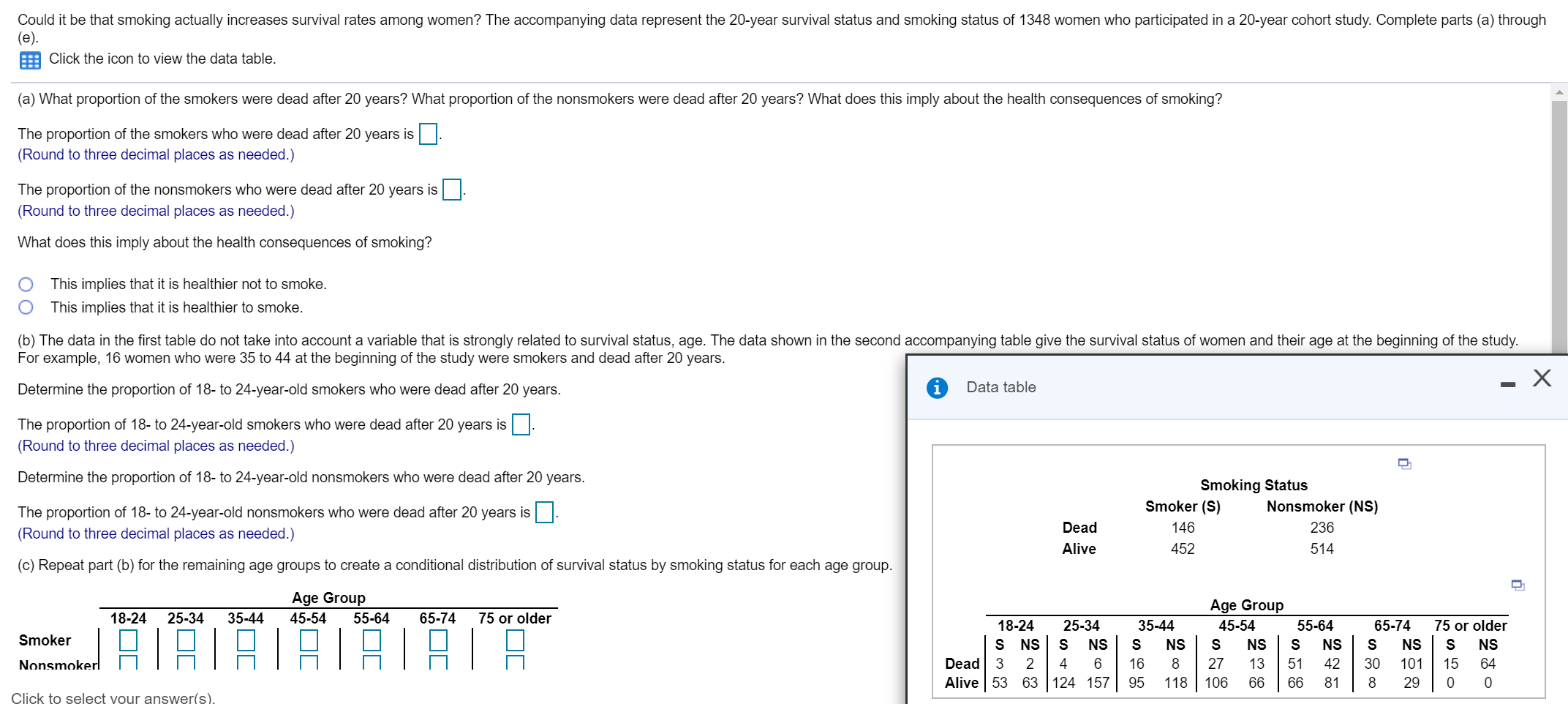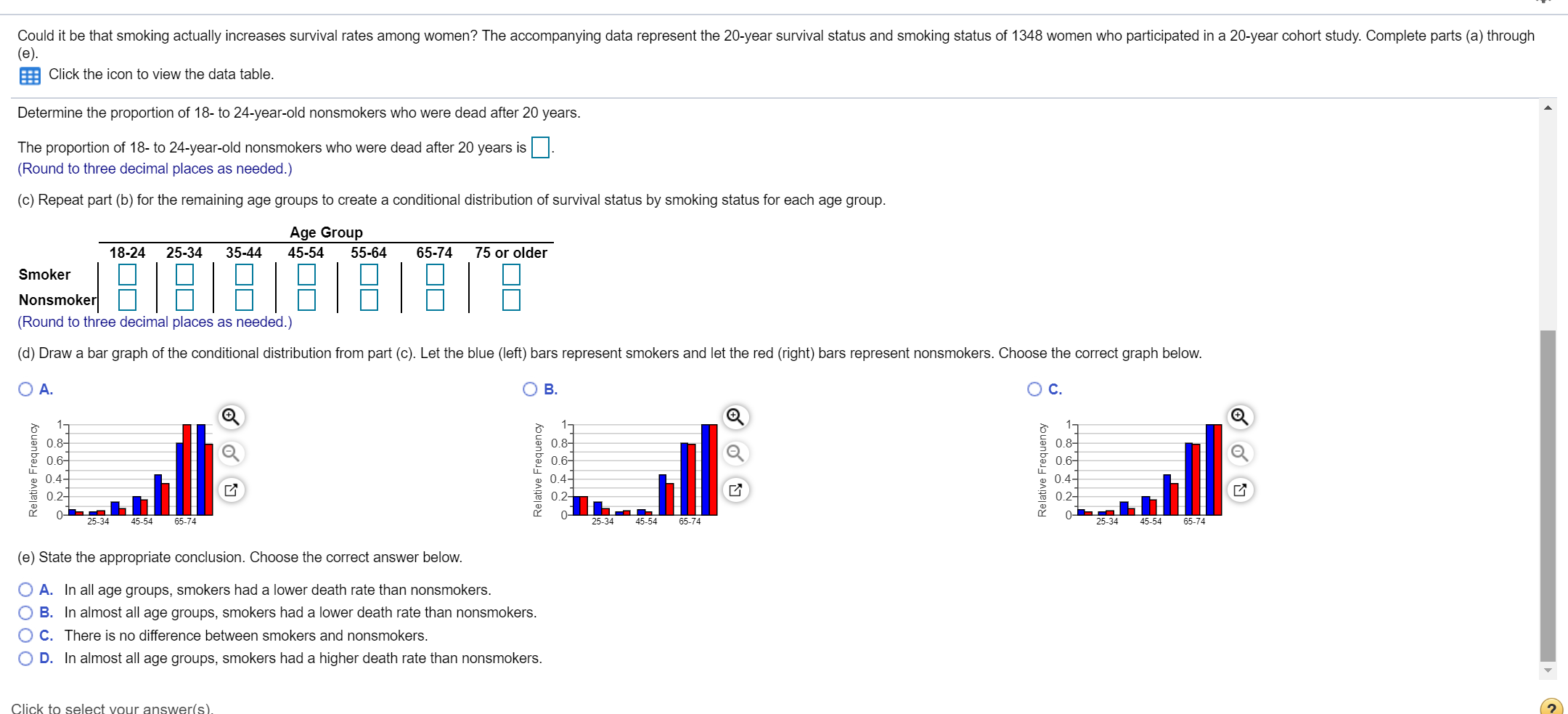Help with the following and how to solve it pls and thank you
Could it be that smoking actually increases survival rates among women? The accompanying data represent the 20-year survival status and smoking status of 1348 women who participated in a 20-year cohort study. Complete parts (a) through (e). a Click the icon to view the data table. (a) What proportion of the smokers were dead after 20 years? What proportion of the nonsmokers were dead after 20 years? What does this imply about the health consequences of smoking? The proportion of the smokers who were dead after 20 years is (Round to three decimal places as needed.) The proportion of the nonsmokers who were dead after 20 years is D. (Round to three decimal places as needed.) What does this imply about the health consequences of smoking? 0 This implies that it is healthier not to smoke. O This implies that it is healthier to smoke. (b) The data in the rst table do not take into account a variable that is strongly related to survival status, age. The data shown in the second accompanying table give the survival status of women and their age at the beginning of the study. For example, 16 women who were 35 to 44 at the beginning of the study were smokers and dead after 20 years. Determine the proportion of 18- to 24-year-old smokers who were dead after 20 years. 0 Data table The proportion of 18- to 24-year-old smokers who were dead after 20 years is (Round to three decimal places as needed.) Q Determine the proportion of 18- to 24-year-old nonsmokers who were dead aer 20 years. Smoking SIatus The proportion of 18- to 24-year-old nonsmokers who were dead after 20 years is Smoker (S) Nonsmoker (NS) (Round to three decimal places as needed.) Dead 146 236 Alive 452 51 4 (c) Repeat part (b) for the remaining age groups to create a conditional distribution of survival status by smoking status for each age group. '3 Age Group Age Group 13"\" 25'34 35\"\" 45'\" 55454 \"5'74 75 ' \"'1'\" 18-24 2534 35-44 45-54 5564 65-74 75 or older 9mm" J ' ' ' ' ' I ' 5 NS 5 Ms 3 NS 5 NS 5 NS 5 NS 5 NS Nnnsmnke I Dead 3 2 4 6 16 8 27 13 51 42 30 101 15 64 Alive 53 63 124 157 95 118 106 66 66 81 8 29 U 0 Click to select vour answer{s). Could it be that smoking actually increases survival rates among women ? The accompanying data represent the 20 - year survival status and smoking status of 1348 women who participated in a 20 - year cohort study . Complete parts ( a ) through* ( e ) . Click the icon to view the data table* Determine the proportion of 18 - to 24-year-old nonsmokers who were dead after 20 years . The proportion of 18 - 10 24- year - old nonsmokers who were dead after 20 years is \\\\ ( Round to three decimal places as needed . ) ( C ) Repeat part ( b ) for the remaining age groups to create a conditional distribution of survival status by smoking status for each age group . Age Group 18 - 24 25 - 34\\ 35 - 44 45 - 54 55- 64 65 - 74\\ 75 or older Smoker Nonsmoker ( Round to three decimal places as needed . ) ( d) Draw a bar graph of the conditional distribution from part ( C ) . Let the blue ( left ) bars represent smokers and let the red ( right ) bars represent nonsmokers . Choose the correct graph below . OA . OB . OC. Q 0 . 87 Youanbar . Q Frequency 0 . 87 Frequency 0 . 8 7 2 0 . 6- 2 0. 67 Q 8 0.6- Q 4 0.47 8 0.47 2 0.4 7 Relative F TO 0 . 27 Relative F { 0.27 Rele $ 0.2^ ^_ TO 65 - 74 25 - 34 6:5-74\\ ( @ ) State the appropriate conclusion . Choose the correct answer below . A . In all age groups , smokers had a lower death rate than nonsmokers ." B. In almost all age groups , smokers had a lower death rate than nonsmokers . O.C . There is no difference between smokers and nonsmokers . D. In almost all age groups , smokers had a higher death rate than nonsmokers








